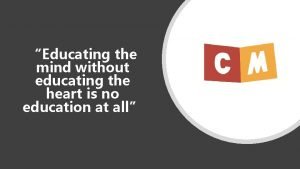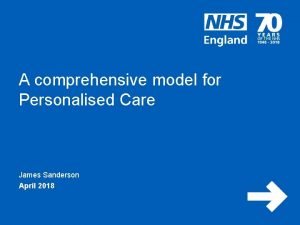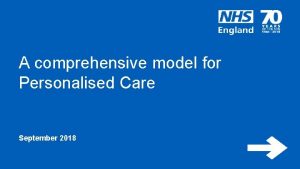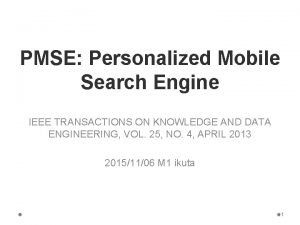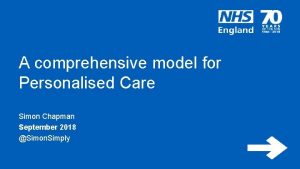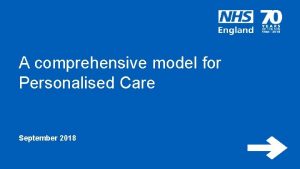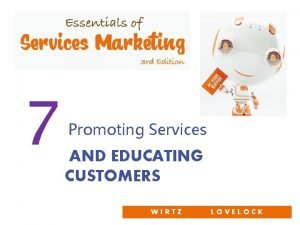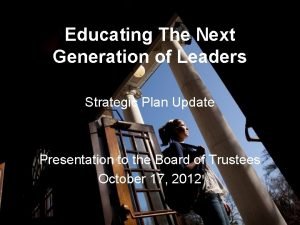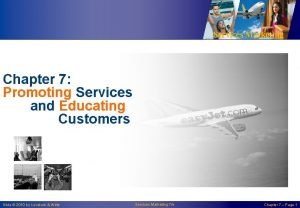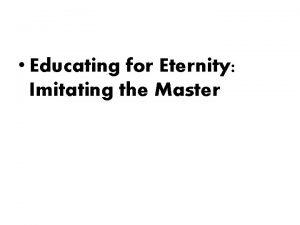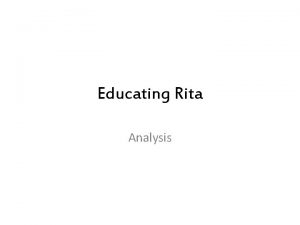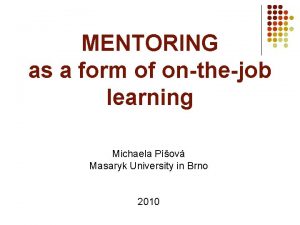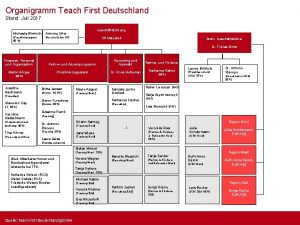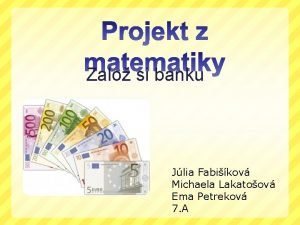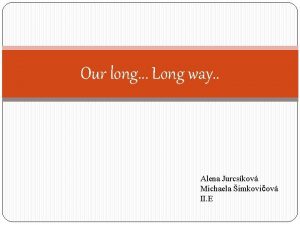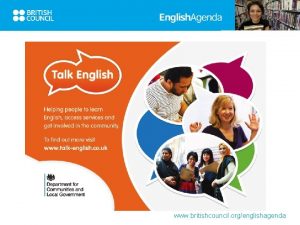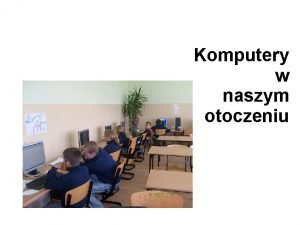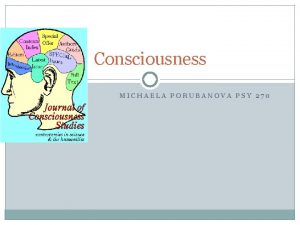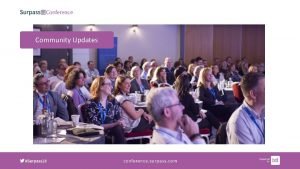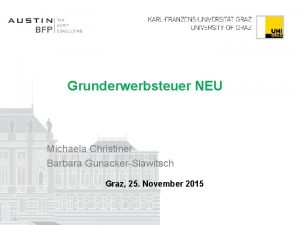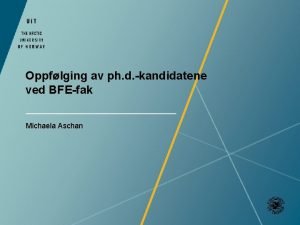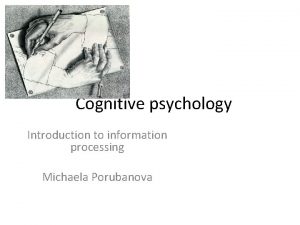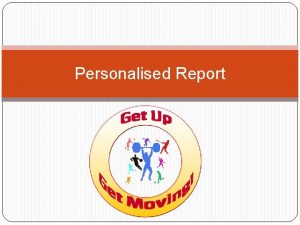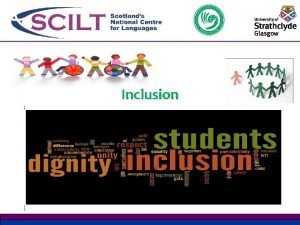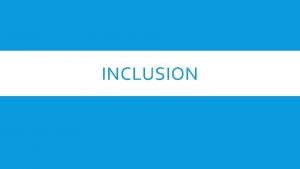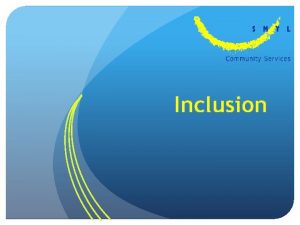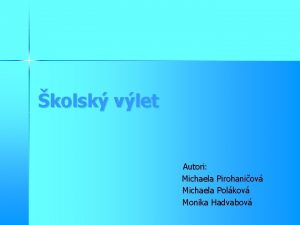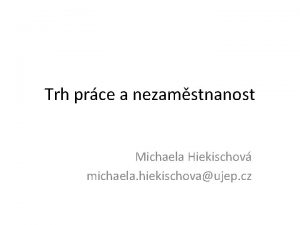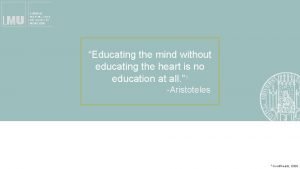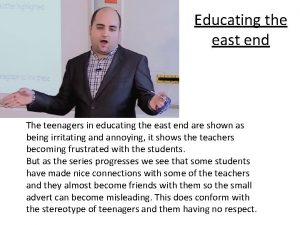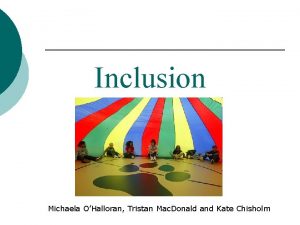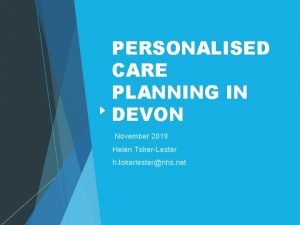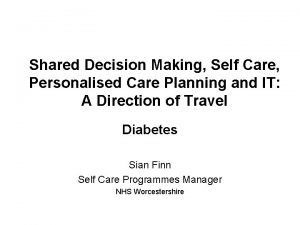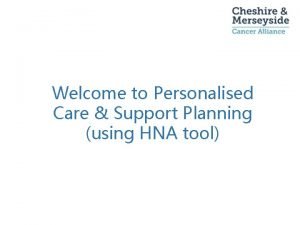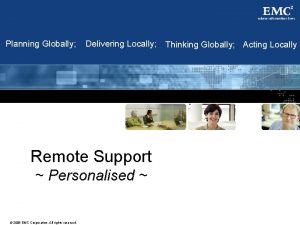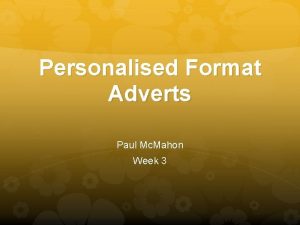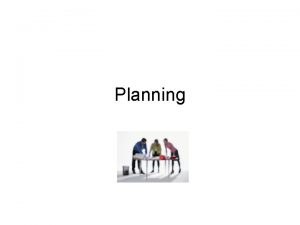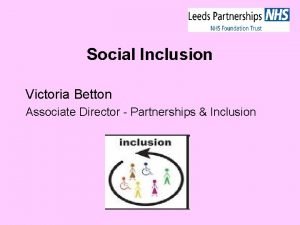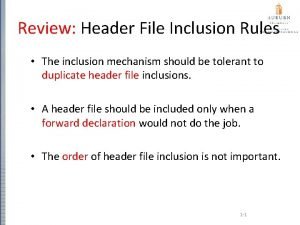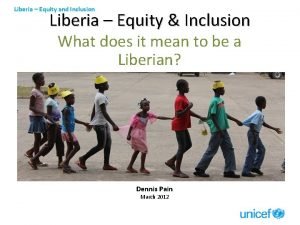EDUCATING FOR INCLUSION WEEK 9 PERSONALISED PLANNING MICHAELA































- Slides: 31

EDUCATING FOR INCLUSION WEEK 9 PERSONALISED PLANNING MICHAELA VERGANO: EXCERPTS FROM LITERATURE REVIEW

LEARNING OUTCOMES AND LECTURE FOCUS • What it student-centred learning • What is Personalised Planning • Types of Personalised Learning Plans

STUDENT CENTRED LEARNING • learner-focused (Hargreaves, 2004; Hingham, Hopkins & Ahtaridou, 2007; Putnam, 2009). • student-centred learning (Hargreaves & Shirley, 2011) • Student-centred learning recognises the needs of diverse learners and individuals • Harris, Spina, Ehrich and Smeed (2013) voice how equity and diversity must be at the heart of student-centered learning for all.

Student-centred schools should: • 1. encompass student-centred pedagogies in the classrooms (p. 6). • 2. work to understand support student learning, rather than focusing on how best to teach or how to cover the curriculum. (p. 12). • 3. understand that assessment is central to developing, sustaining and delivering student-centred learning. (p. 12). • 4. are learner-centred and recognise that all members of the school community need to be supported in their ongoing learning (p. 15). • 5. encourage and listen to student voice and provide legitimate forums for students to express their views and ideas, especially for marginalised students. (p. 22).

• A student-centred approach personalises teaching and learning to meet individual student needs and is more complex and variable than teaching-centred approaches. Rather than simply presenting the curriculum, teachers are required to have deeper knowledge of subjects and more flexible forms of pedagogy as well as tools that access student thinking so that teachers can understand it and build upon it (Darling. Hammond, 1996, p. 11).

• Teachers in a student-centred classroom not only require strong content knowledge but also need to have a toolkit of pedagogical approaches specific to their subjects that they can use to meet the individual needs of diverse groups of students (Cornelius-White, 2007; Vavrus et al. , 2011; Yonezawa et al. , 2012). • Furthermore, teachers adopting a student-centred approach must be adept in “knowing the developmental, cognitive, and learning styles of our students and ensuring that instruction is well matched to each” (Dix, 2012, p. 11).

• In a student-centred school, the traditional paradigm of teaching quality is altered (Vavrus et al. , 2011) with the focus of student-centred classrooms on personalising learning to ensure that the content and pedagogical approaches engage and meet all students’ learning needs (Harris et al. , 2013, p. 22). • For students with disabilities and diverse needs the practice of personalised planning complements student-centred learning and supports an understanding of individualised learning practices (Vergano, 2018)

PERSONALISED PLANNING • According to UNESCO (2012), inclusive education requires a whole school approach where “schools must be ready both to accept students with diverse needs and to behave in proactive ways to eliminate barriers in order to enable full participation” (Loreman et al. , 2014, pp. 9 -10). • Providing this personalised learning and support for students requires schools and teachers to plan how best to respond to the needs of their students (Australian Government Department of Education and Training [AGDET], 2015). • Personalised planning is the process where personalised learning is the centre of a consultation process and collaborative practice (AGDET, 2015) to develop and document the specific needs of students to ensure planning responds to student needs. “No document is more significant for ensuring effective individualised educational

PERSONALISED PLANNING • Specifically mentioned in the AC • The sub-section within the AC on SWD notes that the purpose of having a Diversity section and inclusion of SWD, is to support teachers in meeting their obligations under the DSE (2005). • While the product of personalised planning is a document, there is a process to personalised planning. • The Personalised Plan process involves the student (where appropriate), their parents or carers, teacher/s and other specialists who meet to inform what is included in the document. • The process of personalised planning should ensure all student requirements are met and the most valuable and applicable information is included in the PP to address the

AUSTRALIAN CURRICULUM • Personalised learning is included in the AC to help teachers plan for student-centred learning and differentiation, but more specifically to understand how incorporating ‘reasonable adjustments’ is essential for some students who require personalised planning. • Although not directly referring to ILPs or PPs, the AC does state that personalised learning can occur using the curriculum, instruction and/or the environment. • The ideas, examples and illustrations of personalised planning that are offered in the AC, are a base for teachers to help in any personalised planning that they may need to do for students. • The inclusion of a section on personalised learning in the AC is important, as it acknowledges the diversity of needs in classrooms and the necessity to support teachers in planning and implementing teaching and learning for all students. (Vergano,

PERSONALISED LEARNING PLANS • ILP/IEP Individual Learning Plan/Individual Education Plan • EAP: Education Adjustment Plan, NEP: Negotiated Education Plan • TP Transition Plans • PLP Personalised Learning Plan • Personalised Plan • IDP Individual Development Plan • Student Learning Profiles (Conway & Walker, 2017; Forlin et al. , 2013).

• Rotter (2014) asserts that no document is more significant for ensuring effective individualised educational learning than the ILP. • The intention of the ILP is to facilitate effective instructional planning and make sure services are delivered if needed consistently and in a continuous manner (Hardman & Nagle, 2004). • For this to occur teachers need to have a strong knowledge of the ILP, the planning process and how to implement the requirements of the document.

• The Individual Education Plan (IEP) was first mandated in the United States in the Education for All Handicapped Children Act (1975) and has been described as the cornerstone of special education (Burns, 2007). • The process involves the student (where appropriate), their parents or carers, teachers and other specialists who meet as a group. While all members bring information to the meeting, one aim of the plan is to link a student's needs to the curriculum, with input from each of those present. (Vergano, 2018)

INTERNATIONAL CONTEXT • The practice of designing, writing and implementing individualised and personalised planning has been implemented internationally and across Australian states and territories for a number of decades • Internationally, the personalised plan was first introduced in the US (Christle & Yell, 2010), aligning to the Education for All Handicapped Children’s Act enacted in 1975. It was a mandated document, enshrined in legislation and introduced to ensure eligible students were guaranteed an appropriate public education. • Referred to as the Individual Education Program (IEP), it was developed to ensure students had their unique and diverse needs met and was revised in 1990 with the Individuals with Disabilities Education Act (IDEA) (US Department of Education, 1990) and again in 2004 when the act was renamed the Individuals with Disabilities Education Improvement Act (IDEIA).

• focus of the plan should include the instructional means to provide appropriate learning opportunities with the goal being improved learning outcomes (Zeitlin & Curcic, 2014). • Another aim of the meeting is to document the student's current level of performance and learning goals (Capizzi, 2008), to identify strategies, supports, and resources needed to assist in achieving these goals (Wilczynski, Menousek, Hunter, & Mudgal, 2007), and to develop strategies for evaluating whether the goals have been met (Stroggilos & Xanthacou, 2006; Poed & Elkins, 2012).

NATIONAL CONTEXT • Individualised planning for SWDs is considered good practice (Dempsey, 2012) in catering for the diverse needs of students. • An individualised or personalised plan is not a legal requirement (Timothy & Agbenyega, 2018, ) although the Disability Standards for Education (2005) prescribes that education providers consult with a student and/or their associate (parent, caregiver, etc. ) with regard to all aspects of their educational program. To facilitate these discussions, most Australian states and territories consider the use of an individual planning process as part of the management of resourcing students with disabilities (Shaddock et al. , 2009). The documented plan arising from this process is most commonly known as an Individual Learning Plan (ILP) or Individual Education Plan (IEP) (Conway & Walker, 2017; Forlin et al. , 2013).

ACTED GUIDELINES • 3. 6 The Individual Learning Plan (ILP) identifies the student’s individual needs, pathway, goals and priorities for learning. An ILP is designed by teachers in collaboration with parents and carers, relevant professionals and the student where appropriate, to inform the planning, delivery and evaluation of the student’s personalised learning program. • 3. 7 Every student accessing support under the ACT Student Disability Criteria or who is supported with additional resources or services must have a current ILP. • 3. 8 The teacher with the major responsibility for coordinating and/or delivering the student’s educational program also has responsibility for coordinating the development of the ILP in collaboration with the student and parents and ensuring it is reviewed, at a minimum, on an annual basis. (ACTED, 2008)

PURPOSE • Mitchell, Morton and Hornby (2010) -The document is expected to serve educational, legal, accountability, placement, and resource allocation purposes. • PP “primary purpose is as an educational planning document” (Hirsh, 2013, pp. 51 -52).

PROCESS • Christle and Yell (2010) articulate the process of the Individual Education Program that incorporates a personalised plan: “The individual education program (IEP) is of critical importance… [T]hrough the IEP process school-based teams (a) assess the educational needs of a student, (b) develop meaningful and measurable goals that direct the student’s program, (c) develop and implement a program of special education and related services, and (d) monitor the student’s progress toward his or her goals” (p. 109)

• The process begins the identification of the needs of the students and the need to develop the PP. • It continues along a path that includes the meetings, collaboration, and data baseline testing, to the document produced and (product) recorded and published, then disseminated to teachers. • The phase of interpreting then implementing and evaluating is next. • Evaluating should include reflecting on success or otherwise of the plan, readjustments to the plan and the cyclical process continues. • Elements of best practice around the process include parent and student participation and have been extensively researched (Goepel, 2009; Prunty, 2011; Rose et al. , 2012, Blackwell & Rossetti, 2014).

PRODUCT The formal documentation arising from the planning process is the personalised plan. Howes (2017, p. 95) defines individual learning plans as “[D]ocuments that set out the agreed educational goals of the individual student, as well as the teaching strategies, resources and time frames that apply to those goals”.

• “written record prepared for a specific student where learning goals are specified … and the teaching strategies, resources and supports necessary to achieve these goals” (NCSE, 2006, p. xii). • Similarly, Christle and Yell (2010, pp. 109 -110) record that the “IEP document contains the educational needs of a student, the measurable annual goals that direct his or her program, the special education programming and placement, and the method of data collection that will be used to monitor and report a student’s progress”.

ROLE OF THE TEACHER • The role of the teacher is to provide current assessment data to guide the development of the ILP (Capizzi, 2008; Cheatham, Hart, Malian, & Mc. Donald, 2012). • As well, the teacher needs to be able to identify pedagogical strategies that can be used to ensure that students’ learning needs are met, and the student meets both the goals that are set in the ILP document and the educational outcomes expected by external authorities such as ACARA.

ROLE OF TEACHER CONTINUED • The AC highlights teacher responsibilities in considering ‘reasonable adjustments’ to ensure SWDs are provided with opportunities to participate in education ‘on the same basis’ as students without disability. • Using the AC to meet the learning needs of all students, teachers refer to the learning area content as the starting point in planning teaching and learning programs. They must take account of the range of their students’ current levels of learning, strengths, goals and interests, and personalise learning where necessary through adjustments to the teaching and learning program. (Vergano, 2018)

INDIVIDUAL BEHAVIOUR PLANS • Behavioural Improvement Plan • Behaviour Intervention Plan • Functional Behaviour Analysis • ABA: Applied Behaviour Analysis

BEHAVIOUR • A behaviour is considered a problem when it is “exhibited in the wrong place, at the wrong time, in the presence of the wrong people, and to an inappropriate degree” (Apter, 1982).

• Factors to consider when determining whether behaviour is a problem – frequency, intensity, duration as well as location. Also: socioeconomic and cultural influences and the issue of ageappropriate behaviour. • Behavioural categories of students with special educational needs that concern mainstream teachers are: • Issues of attention and work habits, such as not being able to work unassisted an inability to complete tasks without additional assistance; • Coping with the attitudes and behaviours of others towards them; and • The establishment and maintenance of peer relationships. Research has shown that these behaviours are common not only with students with disabilities or learning difficulties but with all students.

BEHAVIOUR INTEVENTION PROGRAMS The success of an intervention such as a Functional Behaviour Assessment (FBA) hinges on: • understanding why the student behaves in a certain way; and • replacing the inappropriate behaviour with a more suitable behaviour that serves the same function (or results in the same outcome) as the problem behaviour.

Internal External Obtain Something A sense of satisfaction that they have told the teacher off Kudos from their classmates that they have told the teacher off Avoid Something Having to do a task that Classmates seeing that is beyond their ability they can’t do something Communications Aggressive behavious will meet their needs Agreesive behaviours produce the desired outcome

• The function is to get: social reinforcement (eg a response from an adult for calling out during a science lesson), or tangible reinforcement (eg a classmate's workbook or access to a preferred activity). • The function is to escape or avoid: an aversive task (eg a difficult, boring, or lengthy assignment), or situation (eg interaction with adults or certain other peers). • The function is both (eg get the attention of classmates and escape from a boring lesson). • The function is to communicate something (eg that she does not understand the lesson or that he does not like having to answer questions in front of his peers).

FUNCTIONAL BEHAVIOUR ASSESSMENT • A problem-solving process for addressing student problem behaviour. • Should be integrated throughout the process of developing, reviewing, and, if necessary, revising a student’s ILP. • Looks beyond the behaviour itself – • The focus is on identifying significant, pupil-specific social, affective, cognitive, and/or environmental factors associated with the occurrence of specific behaviours.
 Educating the mind without educating the heart
Educating the mind without educating the heart Comprehensive model of personalised care
Comprehensive model of personalised care Comprehensive model of personalised care
Comprehensive model of personalised care Personalized mobile search engine ieee paper
Personalized mobile search engine ieee paper Medolac
Medolac Comprehensive model of personalised care
Comprehensive model of personalised care Xpression document generation
Xpression document generation Personalised care operating model
Personalised care operating model Week by week plans for documenting children's development
Week by week plans for documenting children's development Promoting services and educating customers
Promoting services and educating customers Educating for careers conference
Educating for careers conference Educating the next generation of leaders
Educating the next generation of leaders Promoting services and educating customers
Promoting services and educating customers Educating for eternity
Educating for eternity Educating rita symbolism
Educating rita symbolism Educating rita context
Educating rita context Michaela concept school
Michaela concept school Dr. michaela gruber
Dr. michaela gruber Michaela srnk
Michaela srnk Antoine otter
Antoine otter Michaela fabikova
Michaela fabikova Michaela alena
Michaela alena Shkollat e shekullit 21
Shkollat e shekullit 21 Leszek koziorowski
Leszek koziorowski Never talk bad about your spouse quote
Never talk bad about your spouse quote Michaela porubanova
Michaela porubanova Michaela hesse
Michaela hesse Michaela christiner
Michaela christiner Bradley elementary school fort leavenworth
Bradley elementary school fort leavenworth Michaela frostad
Michaela frostad Michaela porubanova
Michaela porubanova Visual pathway psychology
Visual pathway psychology
